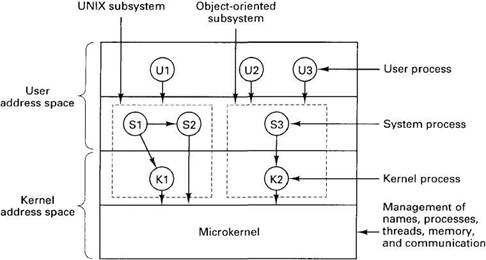Книга: Distributed operating systems
9.1.3. System Structure
9.1.3. System Structure
Chorus is structured in layers, as illustrated in Fig. 9-1. At the bottom is the microkernel (called the nucleus in the Chorus documentation). It provides minimal management of names, processes, threads, memory, and communication. These services are accessed by calls to the microkernel. Over 100 calls exist. Processes in higher layers provide the rest of the operating system. Every machine in a distributed system based on Chorus runs an identical copy of the Chorus microkernel.

Fig. 9-1. Chorus is structured in layers, with a microkernel, subsystems, and user processes.
On top of the microkernel, but also operating in kernel mode, are the kernel processes. These processes can be dynamically loaded and removed during system execution and provide a way to extend the functionality of the microkernel without permanently increasing its size and complexity. Since these processes share the kernel space with the microkernel and with each other, they must be relocated after being loaded. They can invoke the microkernel to obtain services, and can call one another as well.
For example, interrupt handlers are written as kernel processes. On a machine with a disk drive, at system initialization time, the disk interrupt handler process will be loaded. When disk interrupts occur, they will be handled by this process. On diskless workstations, the disk interrupt handler is not needed and will not be loaded. The ability to dynamically load and unload kernel processes makes it possible to configure the system software to match the hardware, without having to recompile or relink the microkernel.
The next layer contains the system processes. These run in user mode, but can send messages to kernel processes (and each other) and can make calls to the microkernel, as shown by the arrows in Fig. 9-1. A collection of kernel and system processes can work together to form a subsystem. In Fig. 9-1, processes S1, S2, and K1 form one subsystem and processes S3 and K2 form a second one. A subsystem presents a well-defined interface to its users, such as the UNIX system call interface. One process in each subsystem is the manager and controls the operation of the subsystem.
On top of the subsystems are the user processes. For example, system calls made by a user process U1 might be caught by K1 and passed on to S1 or S2 for processing. These, in turn, could use microkernel services, where appropriate. Subsystems make it possible to build new (or old) operating systems on top of the microkernel in a modular way, and to allow multiple operating system interfaces to exist on the same machine at the same time.
The microkernel knows which subsystem (if any) each user process is using, and ensures that it is restricted to making the system calls offered by that subsystem. Direct calls from user processes to the microkernel are not permitted, except for those calls that the subsystem defines as legal. Real-time processes can run as system processes, rather than as user processes, and thus make full use of the microkernel without intervention or overhead.
- The structure
- Structure of the shutdown File
- The Fedora File System Basics
- Physical Structure of the File System on the Disk
- Working with the ext3 File System
- Understanding the ext3 File System Structure
- 5.2.2. System Structure
- Index
- 5.3.5. Fault Tolerance
- Easy Firewall Generator
- 6.6.5 SIGEV_THREAD
- Test Driver Code




